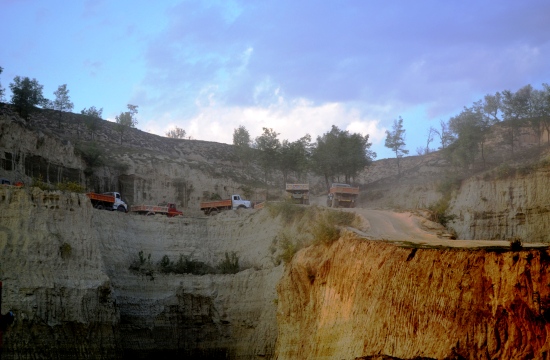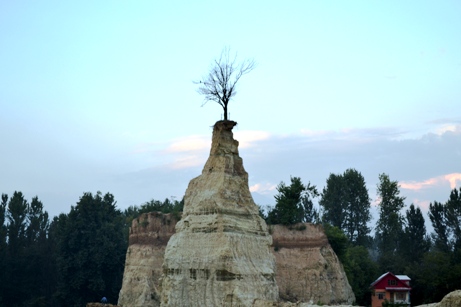Famous Saffron fields of Kashmir have been under an onslaught. Shams Irfan investigates the archaeological diversity hidden underneath the spice fields, and their shocking fate.

As soon as the sun sets behind the thin line of almond trees that dot the remains of the famous Shiv Peand (Shiv’s Resting Place), a heritage Karewa at Patalbagh (Pampore), heavy dumper trucks, like ghosts, emerge from behind the shadowy fields. Moving stealthily, they enter a canyon, where a makeshift dusty road leads them to a waiting earthmover. As the approaching trucks become visible, the earthmover, which stays hidden during the day, comes to life with the loud roar of its engines. Then within minutes, these trucks are filled one by one with tons of precious saffron soil—soil that will be dumped at a nearby construction site. With their headlights deliberately switched off, these trucks then speed away into the darkness.
A few years ago, when the construction of the rail link between Qazigund and Baramulla started in Kashmir, local contractors from Pampore started supplying soil extracted from Shiv Paend and other Karewas of Pampore.
Before the “illegal” extraction of the soil started in Pampore, the Shiv Peand and adjoining Karewas looked like domes of about one square kilometer each, mostly located between the Galendar-Kakaporaand Samboora villages. According to a myth, the Hindu Lord, Shiva used this place as a temporary halting place (Paend).
According to Prof G M Bhat, who heads the department of Geology at Jammu University, “Shiv Peand certainly hosts the records of natural history spanning thousands of years. Some artifacts recovered from the region date back to some hundred thousand years.”
During the initial phase of its excavation, Prof Bhat visited the Shiv Peand a number of times, and observed ruins of the building structures buried at least 100 feet under the soil cover. “A number of human and animal skeletons were seen buried within these sediments at a depth of 100 feet,” he says. “In addition, a number of broken earthen wares, decorated temple crows and bone and stone tools were seen scattered around the excavation site.”
But unfortunately, within a few years, the entire Shiv Peand was razed to the ground. And with that, most of the historically important artifacts were reportedly dumped at the Railway line construction site, along with the saffron soil. “I could manage to collect only one bone implement, one temple crown and fragments of a human skull from the site,” said Prof Bhat.
Ali Mohammad, a local watchman who watches over Shiv Peand and a portion of Somboora Wudur, says “Almost every other week, I find small pieces of earthenware pottery, stones, human bones and even some big parts of what looks like pieces of a granary, scattered on freshly excavated soil.”
Every now and then, in the vicinity of Shiv Peand, a number of animal fossils and stones are seen. This first started with the Yale University Expedition to the ‘State of Kashmir’ in 1931. At that time, expedition members collected limb bones of elephants from the Soamber beds, and reported the existence of stone tools scattered within the top layers of the upper Karewas around there. Around August or September 2000, around two kilometers away from the Shiv Peand, a complete skull and a tusk of an elephant and stone tolls were discovered from the Galander beds at a depth of 55 feet under the soil cover.
According to ProfBhat, the Karewas of Pampore are rich with the remains of our history. In 1999, about three kilometers from Shiv Peand, a local contractor, while clearing a portion of Somboora Karewa for construction of a private building, found Buddha’s idol carved on a stone. Fearing authorities, he simply dumped the 4000-year-old artifact at a friend’s place who finally handed it over to Prof Bhat.
Over the years, the land under saffron cultivation in the town of Pampore has reduced significantly—from 5707 hectares in 1997-1998, to about 3010 hectares in 2006-2007. The productivity of saffron has decreased from 16 metric tons to a meager 6.5 metric tons annually.
“A decade ago when saffron production was high, nobody from our village would have sold his land for extraction of soil. It is due to the rapid decline in the crop that people are looking for options to earn quick money,” said Ghulam Hassan Mir, a 70-year-old local farmer who was offered a handsome amount by local contractors for allowing them to extract soil from his saffron land situated at the western edge of Shiv Peand.
Mir refused without giving a second thought. “Anybody with a conscience would refuse to let our saffron fields be used for filling purposes,” he said. However Mir’s refusal enraged a number of people connected with the soil extraction mafia, but his old age made them stay away from him. In 1990 one hectare of land would yield around 10 kilograms of saffron, but now just around two kilograms per hectare is produced in Pampore and elsewhere.
Over the last few years, people from over-populated Srinagar city started to acquire saffron land and raised private housing colonies on the outskirts of Pampore town. Despite strict laws against use of saffron land for any other purpose, people always find a way around administration and law. Ironically, the area is now known as Saffron Colony. “Government authorities have turned a blind eye towards the issues. They [contractors and land mafia] loot our heritage in broad daylight, and nobody is there to stop them,” said Mir.
“Things get complicated once concrete structures come up at such places where proper excavation is needed,” said Prof Bhat.
Everyday, around a thousand truckloads of saffron soil from the fields of Patalbagh, Hatiwara, Chandhara, Lethapora, Soamber and Wyuyan are being extracted by local contractors and sold to National Highway Authority of India [NHAI] for filling of agriculture land at Tengan, Pampore where a six lane highway is being laid down. The 67 kilometers long highway would consume a total of 890 kanals of fertile agriculture land including a considerable portion of saffron land in Pampore town.
“A truckload of precious saffron soil is sold for as less as Rs 100,” said Manzoor, a local resident and activist who only gave his first name as he fears reprisal from the contractors. Manzoor has discreetly written to the authorities several times against the destruction of saffron Karewas, but says “Nobody seems to care for our saffron fields anymore, otherwise they [authorities] would have taken action against the land mafia.”
In 1999, local contractors started supplying fertile saffron soil from the Karewas of Chandhara, a small village off the National Highway, to IRCON for construction of elevated railway line which connected Qazigund with Baramulla and passes through Pampore.

“I was offered a good sum by a local contractor as this Wudur [Karewas] is among the highest ones in the Chandhara village,” said Mohammad Shafi Bhat, a fifth generation saffron grower who owns six-kanals of fertile land atop Somboora, one of the most famous Wudurs in Pampore town.
Shafi, who works as a driver for a local transporter, said that “It was because of my father that I refused the offer. My father threatened to excommunicate me if I sell the soil from our fields.” Shafi confessed that he was eager to allow extraction of soil from his saffron fields as he was in need of money. Last year, Shafi’s neighbor, who owned a big plot next to his, has now constructed a modest house on the clearing with the money he earned from selling the soil. “Government has banned further extraction in this area,” said Shafi.
In last three years, Wudurs around Chandhara village, the saffron bowl of Kashmir, have shrunken by almost half-square-kilometer at just one location. There are multiple sites where fresh marks of excavation are visible despite the official ban. Locals blame officials for turning a blind eye on this heritage loot. “Our future generation is going to curse us for this plunder. We have looted our own heritage,” said Mir.
Now what remains is the Qutub Minar of Pampore, a pillar shaped slice of land at Somboora, where at the very top, a lone almond tree stands in silent testimony to the destruction of the once famous saffron fields.















